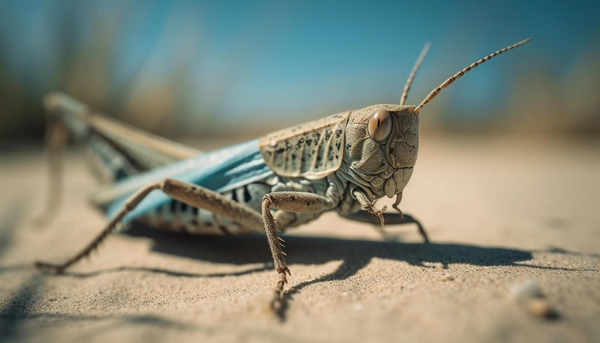For a long time, scientists could not understand why a huge cluster of locusts appears in arid regions of Africa after the first rains. It turned out that insects lay eggs in the soil, which in "sleep mode" wait for the first drops of rain for months.

The Northern Cape and Eastern Cape provinces in South Africa experienced the longest drought in a century a few years ago. A seven-year drought that began due to a lack of rain in February 2013 has wreaked havoc on this sheep farming community.
When the summer rains finally arrived in October 2020, farmers had to contend with a new threat – huge swarms of locusts. The brown locust that lives in this area mostly feeds on grass, but it will eat any green plants and in particular destroys cornfields.
The two provinces are part of the Nama Karu, a large open arid region dominated by low scrub vegetation. The last outbreak of locust activity in the region occurred in 2012, so an interesting question arises: how exactly did the insects survive the long drought and were able to reproduce so quickly immediately after the rains?
The answer is that eggs can survive in the soil for several years, and embryos develop at different rates depending on environmental conditions.
Brown locust (Locustana pardalina) is a locust adapted to an arid climate, endemic to South Africa. This species differs from the swarming locust found in other parts of Africa. It regularly gathers in flocks in the Nama Karu region, and these outbreaks can spread to the southern parts of neighboring Namibia and Botswana.
Females of the brown locust Locustana pardalina can lay up to several hundred eggs at a time. Usually clutches contain 200 to 400 eggs, although this number can vary depending on habitat conditions and food availability.
Usually, the female lays an average of 380 eggs in her lifetime in 6-10 separate nests. The eggs are protected by being in the soil and provided with a porous cap. They are extremely drought tolerant and will remain in the soil until they have enough moisture to hatch. Each egg contains an embryo that will eventually develop into an adult.
As a recent study has shown, the development of the embryo is quite complex. In some eggs, embryo development is delayed regardless of available moisture, while in other eggs the embryo begins to develop as soon as precious water becomes available.
At the same time, both types of eggs can be found in one nest. All embryos of both types of eggs can reduce the speed of their development under adverse environmental conditions. Therefore, the eggs can remain in the soil for several years, while the embryos wait for sufficient moisture to complete development.
This results in synchronous hatching with sufficient rainfall, as all embryos are at the same developmental stage, regardless of when the eggs were laid. Single females tend to lay their eggs in the same places, and therefore there is an accumulation of eggs in them.
5 interesting facts about the brown locust
- An adult brown locust can reach a length of about 5-7 cm and weigh from 2 to 10 grams.
- The brown locust goes through three main stages of development: egg, larva (or nymph) and adult.
- The brown locust plays an important role in ecosystems, participating in the processing of plant waste and serving as a food source for predators and parasites.
- A number of countries have biological control programs for the brown locust, including its use as a protein feed for livestock.
- Scientists and environmentalists are actively researching the brown locust and developing methods to monitor it to prevent or mitigate damage from mass swarms.


 1719
1719












